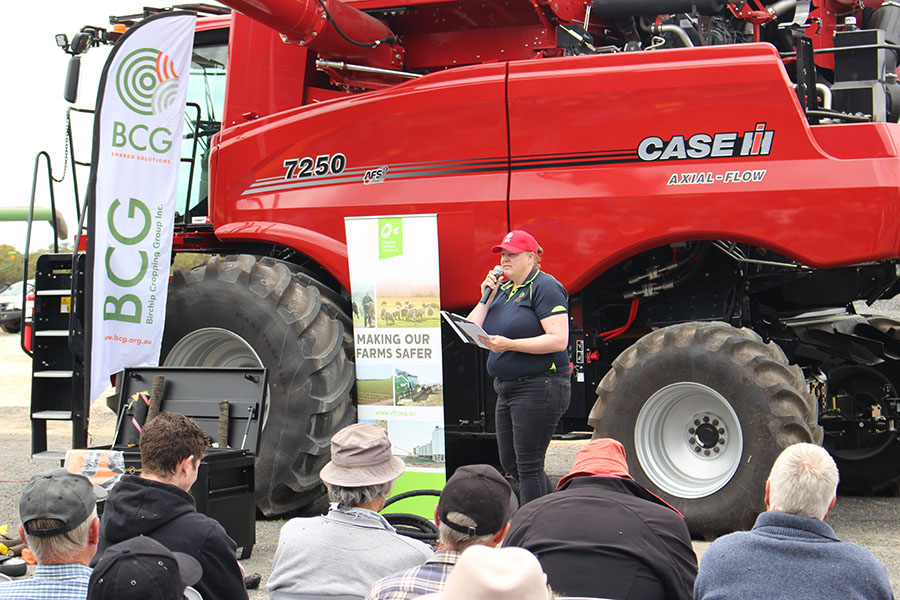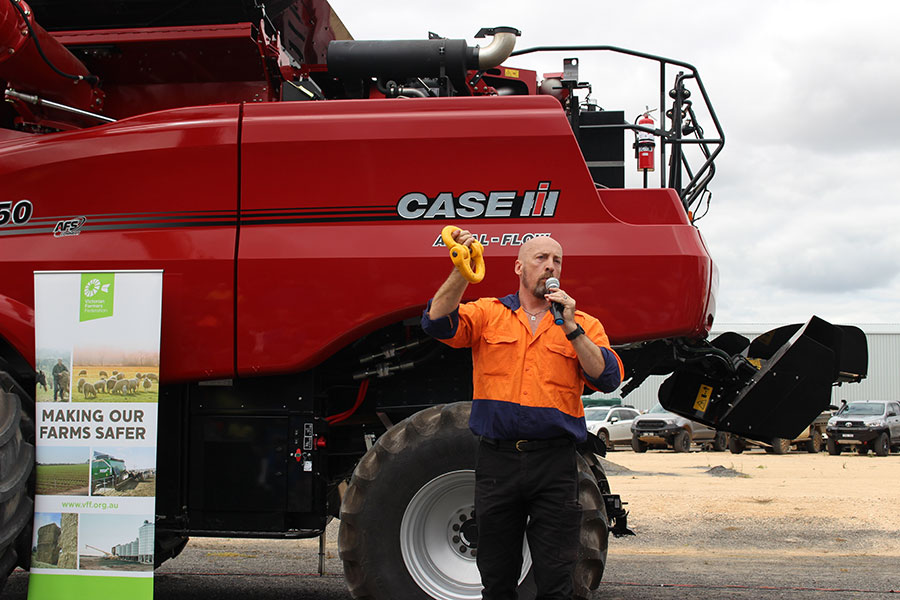More than 550 Victorian grain growers gathered at Warracknabeal recently to learn how to recover bogged machinery safely.
Birchip Cropping Group extension and communications manager Kelly Angel said the session offered practical advice on how to keep growers and equipment safe when working in wet conditions.
“WorkSafe Victoria spoke about the importance of understanding the environment you are working in,” Ms Angel said.
“Before driving into paddocks, think about and avoid the areas that are likely to be wet.

Birchip Cropping Group extension and communications manager Kelly Angel. Photo: Birchip Cropping Group
“Consider what equipment needs to be in the paddock versus what can be parked elsewhere to avoid the risk of bogging.
“It is also helpful to run a team meeting to outline the agreed plan for recovering bogged equipment safely, so everybody knows what to do.”
Warakirri Cropping farm manager Jono Robinson, of Donald, spoke about holding meetings with his team so that everybody understands what to do if equipment becomes bogged.
He requires staff to:
- stop;
- consider whether the bogged gear needs to be recovered immediately;
- think about the best way to extract the bogged gear;
- check the recovery gear available;
- think about how the recovery team communicates with the broader team;
- consider how the recovery is done safely:
- unload grain to reduce weight;
- clear the area near tyres to reduce pressure;
- ensure equipment is attached safely;
- keep bystanders well clear, and ensure clear communication is possible between machinery operators; and
- inspect gear after the recovery to ensure it is ready to be used again.
Warakirri Cropping uses soft shackles and recovery gear that is correctly rated to extract machinery safely.
Victorian Farmers Federation (VFF) farm safety adviser John Darcy spoke about the VFF’s Making Our Farms Safer project, which offers free safety checks for Victorian growers.
Black Snake Australia’s John Johnson spoke about straps, strops and cables and the importance of matching equipment ratings with the maximum recommended gross vehicle weight of a severely bogged vehicle.

Black Snake Australia’s John Johnson outlined the types of recovery gear available. Photo: Birchip Cropping Group
It is important to match ratings of straps, strops and cables with hitching shackle pins and other connecting options. It is equally important to ensure all components for towing are above the maximum gross vehicle weight for severely bogged machinery.
Mr Johnson said all shackles had a working load limit and a breaking limit, which needs to be considered when buying and using gear.
Slow take-off
When recovering heavy vehicles from boggy soil, Ms Angel said, the advice was to avoid taking off quickly.
“Take up the slack slowly, looking at what the bogged machine is doing.
“The consensus was to take up most of the slack before trying to recover large agricultural machinery. Keep at speeds of between two to five kilometres an hour.
“Think about the shock that taking off at 15km/h would put through the recovery gear and the risk of poor unintended outcomes.
“If you can’t recover the equipment using a planned, safe, and controlled manner, you will need to rethink your approach.
“Agricultural equipment is unsuitable for the snatch style used when retrieving bogged four-wheel-drive vehicles because there is too much shock involved.”
Check the manual
Representatives from O’Connors (Case IH) and Emmetts (John Deere) referred growers to the operator’s manual when looking for the best place to attach recovery equipment. Every machine is different.
“Growers running weed seed impact mills or other forms of weed seed management were asked to consider taking these off this year because their low position at the back of the harvester may hinder recovery operations,” Ms Angel said.
“One modification* on display was where galvanised wire rope had been shackled to added points on the front axle of a harvester that extended to the rear of the machine, enabling a recovery strap or strop to be hitched quickly.
“Another grower displayed a similar system as a front-axle recovery kit bought from a supplier.”
After applying tension to one of these systems, Ms Angel said her advice would be to check for any impact on the harvester’s undercarriage.
“We tested one of these systems to see where the straps pulled underneath the machine, and we noticed it hit the undercarriage.
“Consider adding a small amount of tension to such systems first to see what might be damaged and where it sits.
“When in a recovery situation, use dampeners to ensure that if something fails, the recoiling strap and attached hardware stay low to the ground rather than lifting into the air.”
Keep trucks out
Horsham Heavy Towing and Wilken Bulk Haulage representatives were also present. Their discussion focused on keeping trucks out of paddocks.
“It might just mean parking trucks on firm ground and using chaser bins to ferry grain from the harvester to the trucks,” Ms Angel said.
“Our soils are fragile and wet, so consider the merits of protecting soils and keeping trucks or other unnecessary equipment out of paddocks.
“Also, aim to empty bins more regularly to reduce the likelihood of bogging equipment.”
More information: Kelly Angel
* Note: If modifying or adding recovery gear to machinery, it is worth seeking written permission from the seller to ensure that the modification does not void the warranty.

























































